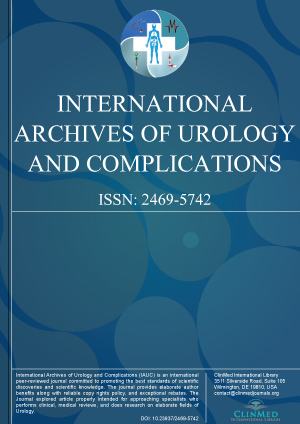Open Access DOI:10.23937/2469-5742/1510067
Effect, Adverse Events and Re-operations after Tension-free Vaginal Tape Obturator Surgery
Silja Maigaard Axelsen, Rikke Guldberg Sorensen, MD, PhD and Susanne Axelsen, MD, PhD
Article Type: Original Article | First Published: December 18, 2019
Women with stress urinary incontinence can be offered an operation with mid-urethral sling. First, Tension- free vaginal tape was invented. Some years later, because of concerns about complications associated with this operation, the other minimally invasive procedure using the trans obturator procedure was introduced by Dr. J. de Leval in 2003. Since then, the diversity in methods gave rise to a discussion of both efficacy, complications and reoperations. In Denmark, the professional discussion...
Open Access DOI:10.23937/2469-5742/1510066
Nephrocutaneous Fistula after Microwave Thermal Ablation and Literature Review
Marius Anglickis, Giedre Anglickiene, Gintare Andreikaite, Lina Miklyciute and Edmundas Starolis
Article Type: Case Report | First Published: December 13, 2019
Nephrocutaneous fistula is a very rare complication of renal surgery. It may be associated with renal tumors, nonfunctional kidneys, staghorn calculi, renal trauma or chronic urinary tract infections. Because of widely used imaging techniques an early detection of small renal tumors has modified the management of kidney cancer. Nephron sparing surgical resection remains the standard of care for T1 tumors less than 7 cm. For patients who are not amenable for surgery, microwave thermal ablation (M...
Open Access DOI:10.23937/2469-5742/1510065
Retzius Sparing (RS) Robotic Assisted Radical Prostatectomy (RARP) and Retzius Space Reconstruction Technique after RARP Improve Urinary Continence Compared to Conventional RARP (C-RARP): Systematic Review and Metanalysis
William Pertuz Genes, Maria Claudia bicudo, Pablo Miranda Machado, Pericles Rios Auad, Liseth Echavez Pacheco, Hamilton de Campos Zampolli, Igor Nunes da Silva, Daniel Coser Gomes and Marcos Tobias-Machado
Article Type: Research article | First Published: November 25, 2019
Several parameters are important to evaluate good oncological and functional results after robotic prostatectomy. We hypothesize that preservation or reconstruction of Retzius space can be valuable for better results outcomes, especially in terms of early continence recovery. In October 2018, electronic searches were conducted in the following databases: Cochrane, EMBASE, PubMed and Google Scholar. Manual searches in the reference lists of all the reviews and the relevant studies were identified...
Open Access DOI:10.23937/2469-5742/1510064
Skull Metastasis in Prostate Cancer: A Compilation of Four Cases along with Review of the Literature
Brahima KIRAKOYA Fasnewinde Aristide KABORE, Babagana Mustapha ABUBAKAR, Mohamed SIMPORE, Bienvenue Desire KY and Aïssata OUEDRAOGO
Article Type: Research Article | First Published: November 06, 2019
Skull metastasis in prostate cancer is rare and is seen in advanced cases. We study four cases seen in our facility with the aim of identifying challenges in making diagnosis and treatment of these patients. We also reviewed the literature. This study involved four men age 55, 65, 66 and 69 years. In two cases, the skull metastases were discovered during evaluation for primary skull swelling, no lower urinary tract symptoms (LUTS) at presentation. In the other two cases, skull metastases were di...
Open Access DOI:10.23937/2469-5742/1510063
Hormonal Evaluation of Adrenal Tumors: What the Common General Practitioner Should Know
Bruno Costa do Prado, Gustavo Silva Schafascheck and Alana Rocha Puppim
Article Type: Research Article | First Published: October 17, 2019
Adrenal tumors may be a benign finding or imply a high level of morbidity and mortality due to their hormonal activity, or to a possible malignant histology. Medical literature indicates that this condition is due to the improvement of the technique and dissemination in a wide range of imaging methods, increasing considerably the diagnosis of adrenal nodules and its immediate treatment. When treating a patient with adrenal tumors, the main concern of the professional should be to establish if th...
Open Access DOI:10.23937/2469-5742/1510062
Risk Factors for Urinary Tract Infection in Men Treated with Transurethral Resection of the Prostate for Lower Urinary Tract Symptoms
J Stangl-Kremser, S Bronimann, M Abufaraj, C Pozo, SF Shariat and G Schatzl
Article Type: Research Article | First Published: October 14, 2019
Our cohort comprised 96 consecutive patients treated with TURP for obstructive lower urinary tract symptoms associated with benign prostatic enlargement suggestive of benign prostate hyperplasia. We collected relevant data of our cohort including demographic data, comorbidities, past medical history presence of preoperative indwelling transurethral catheter and histopathology of prostate chips after resection were assessed for each patient. Patients’ charts were also reviewed to ascertain the ...
Open Access DOI:10.23937/2469-5742/1510060
Case Report on Adult Wilms Tumor and Review of the Literature
Alvaro Sanchez Gonzalez, MD, Joseba Salguero Segura, MD, Victoria Gomez Dos Santos, PhD, Julia Carrasco Valiente, PhD, Ana Martinez Lopez, MD, Javier Burgos Revilla, PhD and Maria J Requena Tapia, PhD
Article Type: Case Report | First Published: September 07, 2019
On December 2014, elective left radical nephrectomy with loco-regional lymphadenectomy and right lobe partial hepatectomy was performed. Despite a good initial evolution, an urgent open hepaticojejunostomy was performed on the 4th postoperative day, as the patient started with elevation of cholestasis enzymes, as well as coluria and acolia, and CT scan described intrahepatic bile duct dilatation and pneumoperitoneum. Afterward, the patient evolved favorably, being discharged on January 2015....

